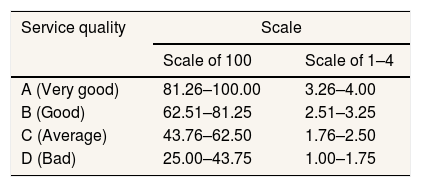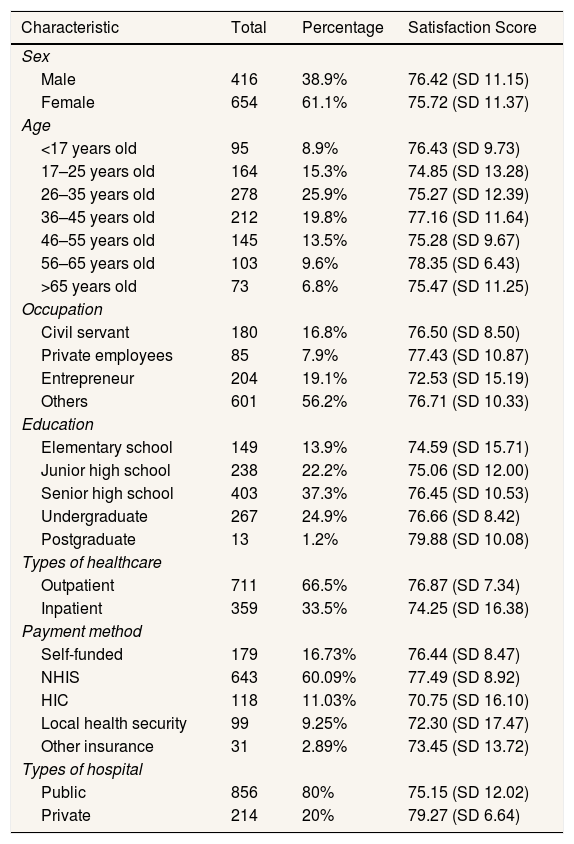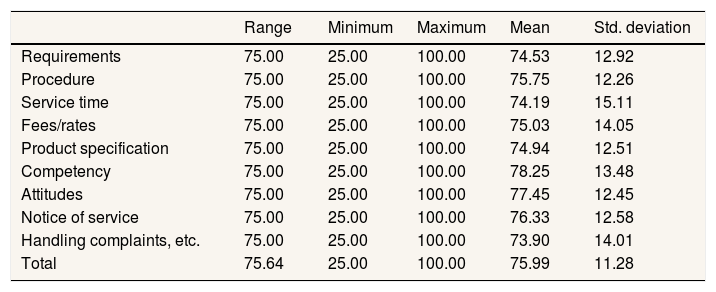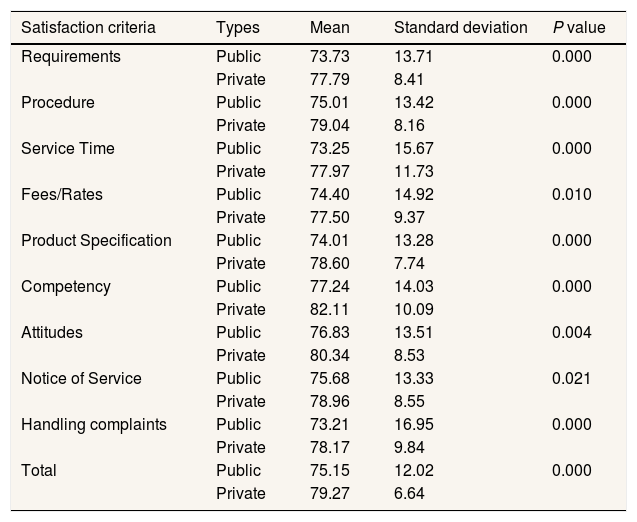
The 3rd International Nursing and Health Sciences Students and Health Care Professionals Conference (INHSP)
More infoThe aim of the study was to compare the level of service satisfaction in public hospitals and private hospitals in Central Sulawesi.
MethodsThis was an analytical observational study with a cross-sectional approach. This research was conducted in 10 hospitals in Central Sulawesi. There were 1070 samples, which were 107 patients in each hospital. The level of patient satisfaction was measured using the Community Satisfaction Index (CSI) Questionnaire, which comprises of 38 closed questions.
ResultsThe average overall satisfaction level was 75.99 (±11.28), which fell into category B for service quality and “Good” for service performance. The highest level of satisfaction was in competencies, reaching 78.25 (±13.48) and the lowest was in Handling Complaints, Suggestions and Feedback, reaching 73.90 (±14.01). In all categories, the level of satisfaction fell into category B for service quality and “Good” for service performance.
ConclusionsThe level of satisfaction of patients who sought treatment at private hospitals was higher than at public hospitals for all categories.
At the beginning of its development, the hospital was a social functioning institution, but now with the establishment of private hospitals, hospitals are more accurately regarded as a health service industry whose management is no different from business entities. In realizing a competitive hospital, both public hospitals and private hospitals always seek to gain public trust by organizing an efficient, effective and quality health service system within the framework of quality control and cost control in hospitals. In improving quality, safety, and patient satisfaction, hospitals refer to service standards based on hospital accreditation guidelines.1
There are still many shortcomings in the implementation of public services that affect the quality of services for the community. This condition, if not responded properly, will bring a bad image to the hospital itself. Given the many types of services, service guidelines are needed as a reference for health agencies. The increasing demand of the community for improving the quality of health services has resulted in the need to improve the function of services for patient satisfaction. The concept of patient satisfaction focuses on assessing the quality of services and health care process for patients in hospitals. In addition, it also describes the patients’ hopes and real experiencein getting services according to the service standards. The quality service will affect patient satisfaction and thus increase patients’ loyalty.2–4
Based on these problems, it is very necessary to evaluate the services of public hospitals and private hospitals in the Central Sulawesi region so that the level of patient satisfaction can be known. In addition, the rationale for conducting this research was based on the fact that public hospitals and private hospitals had rather different organizational visions in providing health services.
MethodsThis was an analytical observational study with a cross-sectional approach. The subjects in this study were both outpatients and inpatients in 10 hospitals in Central Sulawesi namely Anutapura Public Hospital, Undata Regional Public Hospital, Woodward Safety Hospital, Budi Agung Hospital, Wirabuana Hospital, Kabelota Regional Public Hospital, Anuntaloko Regional Public Hospital, Bungku Regional Public Hospital, Mokopido Regional Public Hospital, and Luwuk Regional Public Hospital. The samples were chosen based on purposive sampling technique. Each hospital has 107 samples of inpatient and outpatient patients, so that makes 1070 of total samples.
The level of patient satisfaction was measured using the Community Satisfaction Index (CSI) Questionnaire, which comprises of 38 closed questions. The questionnaire was categorized into 9 scopes based of the community satisfaction survey based on Ministry of Administrative and Bureaucratic Reform, namely (1) Requirements, (2) Procedure, (3) Service time, (4) Fees/rates, (5) Product Specification, (6) Competency, (7) Attitudes, (8) Notice of service and (9) Handling complaints, suggestions, and input.5 The score was calculated with a Likert scale with the following descriptions: value one for very dissatisfied, value two for dissatisfied, value three for satisfied, and value four for very satisfied. The overall score then will be analyzed and categorized of service quality determined as follows (Table 1).
ResultsOut of 1070 respondents, female outnumber male patients by around six to four. On the contrary, the satisfaction score of male were higher than female patients. The highest age range of respondents was 26–35 years old and the least was at age >65 years. Meanwhile respondents at 17–25 years had highest score and they at 56–65 years old had the lowest satisfaction score. Occupations of respondents varied, most of them were other occupations, which included housewives, students, farmers, or even unemployed people. Meanwhile, jobs as private employees had the least percentage and the highest satisfaction score, while entrepreneur had the lowest score. Most respondents had the latest education equivalent to high school, which was as many as 403 people, while the respondents who had attended post-graduate programs had the least number of only 13 people. The satisfaction score based on education were increased along with the level of education, which means postgraduate patients had highest score. Satisfaction level of outpatients were higher than inpatients. More than half of the sample made payments using National Health Insurance Scheme (NHIS), as many as 643 people, and they had the utmost satisfaction score. While those using other insurance payments (private insurance) were at least 31 people, and the lowest satisfaction score was on patients with HIC (Healthy Indonesian Card) (Table 2).
Characteristics of the respondents.
| Characteristic | Total | Percentage | Satisfaction Score |
|---|---|---|---|
| Sex | |||
| Male | 416 | 38.9% | 76.42 (SD 11.15) |
| Female | 654 | 61.1% | 75.72 (SD 11.37) |
| Age | |||
| <17 years old | 95 | 8.9% | 76.43 (SD 9.73) |
| 17–25 years old | 164 | 15.3% | 74.85 (SD 13.28) |
| 26–35 years old | 278 | 25.9% | 75.27 (SD 12.39) |
| 36–45 years old | 212 | 19.8% | 77.16 (SD 11.64) |
| 46–55 years old | 145 | 13.5% | 75.28 (SD 9.67) |
| 56–65 years old | 103 | 9.6% | 78.35 (SD 6.43) |
| >65 years old | 73 | 6.8% | 75.47 (SD 11.25) |
| Occupation | |||
| Civil servant | 180 | 16.8% | 76.50 (SD 8.50) |
| Private employees | 85 | 7.9% | 77.43 (SD 10.87) |
| Entrepreneur | 204 | 19.1% | 72.53 (SD 15.19) |
| Others | 601 | 56.2% | 76.71 (SD 10.33) |
| Education | |||
| Elementary school | 149 | 13.9% | 74.59 (SD 15.71) |
| Junior high school | 238 | 22.2% | 75.06 (SD 12.00) |
| Senior high school | 403 | 37.3% | 76.45 (SD 10.53) |
| Undergraduate | 267 | 24.9% | 76.66 (SD 8.42) |
| Postgraduate | 13 | 1.2% | 79.88 (SD 10.08) |
| Types of healthcare | |||
| Outpatient | 711 | 66.5% | 76.87 (SD 7.34) |
| Inpatient | 359 | 33.5% | 74.25 (SD 16.38) |
| Payment method | |||
| Self-funded | 179 | 16.73% | 76.44 (SD 8.47) |
| NHIS | 643 | 60.09% | 77.49 (SD 8.92) |
| HIC | 118 | 11.03% | 70.75 (SD 16.10) |
| Local health security | 99 | 9.25% | 72.30 (SD 17.47) |
| Other insurance | 31 | 2.89% | 73.45 (SD 13.72) |
| Types of hospital | |||
| Public | 856 | 80% | 75.15 (SD 12.02) |
| Private | 214 | 20% | 79.27 (SD 6.64) |
Table 3 shows that the average overall satisfaction level was 75.99 (±11.28), which fell into category B for service quality and “Good” for service performance. The highest level of satisfaction was in competencies, reaching 78.25 (±13.48) and the lowest was in Handling Complaints, Suggestions and Feedback, reaching 73.90 (±14.01). In all categories, the level of satisfaction fell into category B for service quality and “Good” for service performance.
Descriptive data of satisfaction level.
| Range | Minimum | Maximum | Mean | Std. deviation | |
|---|---|---|---|---|---|
| Requirements | 75.00 | 25.00 | 100.00 | 74.53 | 12.92 |
| Procedure | 75.00 | 25.00 | 100.00 | 75.75 | 12.26 |
| Service time | 75.00 | 25.00 | 100.00 | 74.19 | 15.11 |
| Fees/rates | 75.00 | 25.00 | 100.00 | 75.03 | 14.05 |
| Product specification | 75.00 | 25.00 | 100.00 | 74.94 | 12.51 |
| Competency | 75.00 | 25.00 | 100.00 | 78.25 | 13.48 |
| Attitudes | 75.00 | 25.00 | 100.00 | 77.45 | 12.45 |
| Notice of service | 75.00 | 25.00 | 100.00 | 76.33 | 12.58 |
| Handling complaints, etc. | 75.00 | 25.00 | 100.00 | 73.90 | 14.01 |
| Total | 75.64 | 25.00 | 100.00 | 75.99 | 11.28 |
Table 4 shows that the level of satisfaction of patients who sought treatment at private hospitals was higher than at public hospitals for all categories. In addition, the Mann–Whitney test results for all categories showed that there were significant differences in satisfaction levels for all categories (P-value <0.05).
Comparative test of satisfaction level based on hospital type.
| Satisfaction criteria | Types | Mean | Standard deviation | P value |
|---|---|---|---|---|
| Requirements | Public | 73.73 | 13.71 | 0.000 |
| Private | 77.79 | 8.41 | ||
| Procedure | Public | 75.01 | 13.42 | 0.000 |
| Private | 79.04 | 8.16 | ||
| Service Time | Public | 73.25 | 15.67 | 0.000 |
| Private | 77.97 | 11.73 | ||
| Fees/Rates | Public | 74.40 | 14.92 | 0.010 |
| Private | 77.50 | 9.37 | ||
| Product Specification | Public | 74.01 | 13.28 | 0.000 |
| Private | 78.60 | 7.74 | ||
| Competency | Public | 77.24 | 14.03 | 0.000 |
| Private | 82.11 | 10.09 | ||
| Attitudes | Public | 76.83 | 13.51 | 0.004 |
| Private | 80.34 | 8.53 | ||
| Notice of Service | Public | 75.68 | 13.33 | 0.021 |
| Private | 78.96 | 8.55 | ||
| Handling complaints | Public | 73.21 | 16.95 | 0.000 |
| Private | 78.17 | 9.84 | ||
| Total | Public | 75.15 | 12.02 | 0.000 |
| Private | 79.27 | 6.64 |
The results of the CSI study on service quality indicated that all categories of service, which were based on indicators in the Decree of the Minister of Administrative and Bureaucratic Reform No. 25/2004 concerning General Guidelines for the Creation of the CSI, fell into category B for service quality and “Good” for service performance, with total satisfaction of all category reaching 75.99 (±11.28). This is in accordance with the analysis in semester II of 2017 at the Abdul Wahab Hospital in Sjahranie Samarinda, showing that hospital services were categorized as B and “Good” for service performance, meaning that they were deemed able to meet the community's expectations of the services provided. The increase in satisfaction index did not only occur in the total CSI but also in each of the categories of service. Improvements and innovations were always carried out based on the results of previous surveys, both internally and externally. The community as users of the hospitals had an important role in providing input for these improvements.6
The results of this study indicated that the patient satisfaction level of all service elements in private hospitals was 79.27 (±6.64) higher than those at public hospitals which only reached 75.15 (±12.02). The comparative tests were carried out with the Mann–Whitney test, showing the results of P value=0.000. This finding is in line with research carried out by Khattak et al. which showed that the level of patient satisfaction in private hospitals was 68%, while that in public hospitals was 46%, seen from the aspect of access, communication with doctors, financial aspects, interpersonal relations, service time and quality of service.7 A study conducted by Chari's et al. found that the increase in patient satisfaction in private hospitals compared to that in public hospitals was due to the absence of General Health Plans. Hospitals were included in the state health system, so that hospital strategic planning and operational needs in supporting service processes and budget used in public hospitals could be more effective.8
In contrast, Hutama et al. found that there was no difference in the level of satisfaction in public hospitals and private hospitals.9 In addition, Irfan's research found that the low quality of health services for public hospital patients compared to private hospitals was due to the many factors that affected the quality of services, including government funding, lack of government interest in developing new health projects in rural areas and increasing burden of hospitals due to the level of population growth and urbanization.10 Other factors that could have also affected patient satisfaction toward service quality according to Firdaus included registration, waiting time, fast service, friendliness and courtesy of officers, skills and care of medical staff, cleanliness of the rooms, and complete facilities found in private hospitals and public hospitals.11 The results of the research on requirements showed that the public in general assessed that the hospital's service requirements had been in accordance with the type of service and it was very easy to complete the requirements. This is in accordance with the results of the CSI Survey of the Sidawangi Lung Hospital in West Java stating that the element of requirements must be maintained so that obtaining services is not difficult; besides, it is in accordance with the standards of the hospital services.6 Based on the results of research on the service procedure, the community was satisfied but both the public hospitals and private hospitals were deemed not to provide convenience. Improvements are needed because the service flow has not been well socialized. Therefore, additional information media is needed, both in the form of leaflets, banners, information boards (television), and other information that is easily accessible to patients. According to Ahmed, S. et al., service procedures in private hospitals are easier to follow because of the continuous improvement in health information technology.12
The results of the research on the service time, elements related to the speed of service, indicated that the speed of service varied greatly. One way to improve service quality is to improve the timeliness of services related to waiting time, the processing time to complete the entire service process from the type of service needed from each patient. This is in accordance with a study stating that long service waiting times can be a factor that influences patient dissatisfaction with service quality and hospital quality, which eventually decreases patient loyalty to hospital.13
The results of the research on the elements of costs showed that the cost of services in hospitals was based on hospital decrees if patients were subject to public rates and commercial insurance, and based on legislation if patients used BPJS or other health insurance programs from the Indonesian government. The elimination of the obligation to pay only applied to the poor and to health insurance participants, by showing evidence needed as a requirement when registering. This is consistent with the research of Bamfo & Dogbe who reported that since the people of Ghana joined the National Health Insurance Scheme, the financial burden on patients getting services in hospitals was greatly reduced. However, there were also patients who were willing to pay high prices to get quality health services in private hospitals.14 According to the Decree of Ministry of Administrative and Bureaucratic Reform No. 25/2004, the certainty of service costs is a match between costs paid and cost set based on hospital service cost standards.5 This shows that there should be clarity, transparency, and accountability regarding the details of service costs. In general, people were satisfied with payments at private hospitals because the costs were very clear and detailed.
The research results on the product specifications of the type of service indicated that the results of services provided and received by patients are in accordance with the stipulated conditions, in which all types of services carried out in hospitals were always based on patient needs in accordance with agreed service quality indicators and the Minimum Service Standards of each hospital. This is in accordance with the research carried out by Alijanzadeh et al. which found that the community chose private hospitals because of their types of services.13
The results of the study on the competency indicated that the community considered officers to have worked in accordance with their competencies, expertise, skills, and experience in each service unit, although there were some officers who had experienced a decline in physical conditions due to their long serving time in hospitals. Private hospitals in their human resource management system considered the age of officers as one of the factors that would affect their performance or hospital performance which indirectly affected patient satisfaction in receiving all forms of services in hospitals. According to Alijanzadeh et al., the competence of staff and doctors was better in private hospitals than in public hospitals.13
The results of the study on the attitude showed that most patients expressed satisfaction at the private hospital because the officers (doctors, nurses, and other non-medical officers) were friendly, smiling, neat, and clean compared to the officers in public hospitals. This is in accordance with the results of the study of Ghazanfar et al. that doctors in private hospitals had better interpersonal skills than doctors in public hospitals. Patients treated at private hospitals received very good service from doctors because of the difference in the amount of payments made by patients in private hospitals, because private hospitals focused on meeting customer demand.10 Basu et al.’s research stated that officers in public hospitals were mostly unfriendly to patients and rarely arrived on time.15
The results of the research on the notice of service element indicated that the hospitals were able and obliged to provide health services to the community in accordance with the service standards set by the Hospital. This is supported by the CSI Survey report on services at Dr. Cipto Mangunkusumo Public Hospital which demonstrated excellent service performance.6 The results of the research on handling complaint, suggestion, and feedback indicated that the community stated that private hospitals provided more suggestion boxes at several important service points such as in emergency installations, outpatient care, and inpatient care and provided clear directions to the complaints handling room and the distance was not too far from the service center in the hospital. This element fell into the category B for service quality and “Good” for service performance. This is supported by the CSI Survey report on services at Dr. Cipto Mangunkusumo Public Hospital which demonstrated excellent service performance.6
Patient satisfaction with hospitals did not lie in their ownership status (public or private), but in meeting patients’ needs for health services. The level of satisfaction of patients who sought treatment at private hospitals which were found to be higher than that at public hospitals was likely due to several reasons. First, service quality in private hospitals tended to be better because their management system, especially their inputs (man, money, methods, materials, machines) greatly supported the success of the service process in hospitals which would then affect output. In terms of input, doctors, as people who played an important role in providing services to patients, should have competence, skills, experience, interpersonal communication, discipline, and good ethics. In general, the behavior of doctors in private hospitals tended to be more professional because of clarity of reward and punishment. Doctors realized that working in public hospitals provided lower incentives than working in private hospitals. Although the incentives were low, doctors had a sense of responsibilities and tended to be good doctors because they remembered the doctor's oath that must be upheld as a form of community service and most doctors who worked in government education hospitals received different rewards, namely becoming clinical lecturers at the Medical Faculty. As with money, patients seeking treatment at private hospitals expected a match between the fees paid and the services obtained. At the private hospitals, the certainty of these costs was in accordance with the expectations and needs of the patient. The method in private hospitals, one example, the service flow was more directed and very easily understood by patients and the service package offered was made more attractive. Materials in private hospitals in terms of facilities and infrastructure were more complete and hospital designs were made more attractive and comfortable as if patients were staying at hotels. Procurement of machines in public hospitals and private hospitals had a different system, starting with proposals, planning, and purchasing, even though both of them buy through e-catalog. Thus, patients were more satisfied with private hospitals because managerial systems in private hospitals prioritized excellent service so that the output produced was the creation of patient safety and satisfaction which in turn could also increase patient trust in the hospital.
Second, the organizational culture of private hospitals, especially religious-oriented private hospitals, tended to instill ethical and moral values in patient-focused services. In addition, the vision of private hospitals was very different from that of public hospitals. It showed the direction of the hospital strategy in optimizing existing resources. The application of organizational culture to employees would also increase motivation in work, so that it may impact on performance, and indirectly would have a major effect on patient care, including an efficient and effective culture of behavior which is one of the important cultures to be understood and implemented in the current era of National Health Insurance. The third is commitment. Patient satisfaction with service quality required a strong foundation of commitment from all employees, especially doctors. The commitment of doctors working in private hospitals to service was very high; however, most doctors still maintained a professional attitude knowing the potential rewards they could get in this case in the form of salaries, health insurance, security guarantees, and incentives given by the private hospitals.
A critical challenge in the coming years is how to overcome the dynamic competition between private hospitals and public hospitals, where we know that most doctors who work in private hospitals are also full-time doctors in public hospitals, a situation which greatly disrupts the performance of doctors in providing services to patients. The role and support of relevant stakeholders are important ining maintain discipline of the working hours of doctors so that the quality of hospital services and the level of patient satisfaction with the service can be controlled. Increasing patient satisfaction in private hospitals is an effective way to get patient loyalty. Patient loyalty is one of the strategic objectives of the private hospital to expand their range of services.4,16
ConclusionThe level of satisfaction of patients who sought treatment at private hospitals was higher than that of patients treated at public hospitals in all elements.
Ethical clearanceEthical approval was granted by a medical committee from the Faculty of Medicine, Tadulako University.
Consent for publicationInformed consent has been obtained from all the participants.
Availability of data and materialsThe authors confirm that the data supporting the findings of this study are available within the article.
FundingThis study was supported and funded by Central Sulawesi Provincial Health Office in the amount USD 5.185.
Conflict of interestThe authors declare no conflict of interest, financial or otherwise.
The authors say thank to the Central Sulawesi Provincial Health Office, Tadulako University School of Medicine and the Hospital.
Peer-review under responsibility of the scientific committee of the 3rd International Nursing, Health Science Students & Health Care Professionals Conference. Full-text and the content of it is under responsibility of authors of the article.

















